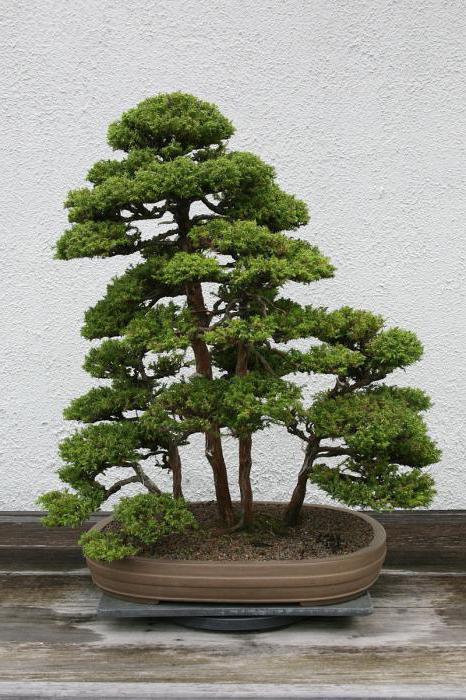Japan and China are the birthplace of an evergreen tree called Japanese cryptomeria. Residents of the Land of the Rising Sun consider it their national tree. Under natural conditions, grows on the northern slopes of the mountains and plains. They plant it in forest plantations, decorate park alleys with it.
Plant description
Cryptomeria Japanese - a plant known since ancient times.
The age of the tree reaches 150 years, its height can be 60 meters or more. The trunk in girth may have two or more meters. Japanese cryptomeria has a very dense crown of light or dark green color.
Male and female spikelets grow on the tree.
The crown is formed in the form of a regular pyramid. The bark is brown in color with a reddish tint. In the process of growth, the crust exfoliates in long narrow stripes.
Cultural forms of a tree may have a green crown with a yellowish or reddish hue. The shoots on the branches are flexible, covered with small hard needles with pointed tips and very small spherical cone-fruits with a brown tint. Their diameter does not exceed 2 cm, the fruits are located at the end of the shoot. They ripen in the first year and are released from seeds with the onset of autumn.
The tree, as already mentioned, has female and male spikelets growing at the ends of the tree shoots. Male spikelets with stamens in the form of scales have an oval shape, they are arranged in a spiral. There are dust bags on the underside of the spikelet.
Female spikelets at the base are covered with leaflets in the form of scales. They are almost completely spliced at the base. Covering and seed flakes have up to five ovules.
Japanese cryptomeria propagates by seeds, cuttings, inoculation, processes. Under natural conditions, trees grow very quickly, which contributes to their popularity not only in China and Japan.
Cryptomeria cultivation regions
The cryptomeria of the cypress family attracts attention with its natural beauty. In the middle of the XIX century, it began to be cultivated in Europe.
To date, Japanese cryptomeria has given birth to many varieties. There are cultures for greenhouses, various enclosed spaces, including for growing in a room.
The Japanese cryptomeria developed by breeders (a photo of it is often found in gardening magazines) is also used to decorate the house.
Garden forms of the evergreen beauty are especially common in areas with a mild subtropical climate. In Russia, the plant is popular in the Crimea and the Caucasus. Fluffy trees of a beautiful pyramidal shape adorn parks, gardens, greenhouses in these regions.
German gardeners have grown over 20 varieties of this unique plant. Among them stand out winter-hardy varieties. However, a temperature of 10-12 degrees below 0 for these forms of evergreen cryptomeria is a rather difficult test.
Dwarf plant varieties do not exceed two meters in height, domestic species are found that are no more than 1.5 m high. Such crops are grown mainly as tub crops.
Evergreen Cryptomeria in Home Collections
For such an exotic evergreen plant as Japanese cryptomeria, care at home needs to be thorough. The following conditions are necessary for him:
- Good lighting. You need a bright room without direct sunlight.
- The temperature in summer should not be higher than 15 ° C, and in winter - about 8-10 ° C. The room in which Japanese cryptomeria grows should be regularly ventilated, avoiding drafts.
- An evergreen house plant needs frequent watering during its active vegetation period - from spring to late autumn. In winter, watering is reduced. With the onset of frost, home cryptomeria is not watered at all. Excessive water that the roots did not absorb is harmful to the plant. After watering, remove excess water.
- Japanese cryptomeria is a moisture-loving culture, with drought, the plant begins to drop needles. If the room has dry air, cryptometry should often be sprayed using a spray gun.
- During the active spring and summer vegetation, the plant needs to be fed. For this, fertilizers for indoor plants are used, diluted in water intended for irrigation. It is necessary to alternate top dressing with conventional fertilizers with the addition of organic matter.
- Dwarf trees growing at home should be replanted every five years. Start transplanting in the spring, before the start of an active vegetation. The soil for planting cryptomeria is a mixture of equal parts of compost, sheet land and river sand. Good drainage is needed.
- At home, cryptomeria is propagated by cuttings and seeds. The stem, taken from a young, not lignified shoot of the plant, must be treated with heteroauxin or preparations based on it and planted in the prepared soil. Having covered the stalk with a film, it is watered, keeping the surface of the upper layer moist until rooting.

The seed method of reproduction is also used. Seeds are planted in a box, sprinkled with soil, moisten its surface and cover with glass. Planted seeds are regularly watered. The ambient temperature in the greenhouse is maintained somewhat elevated.
Features of growing plants
Young shoots grown from cuttings and seeds need to be pinched. Perform this procedure regularly, forming a plant so that the shoots growing from the trunk and skeletal branches are removed.
With the onset of spring, very bare sections should be cut. The branches of cryptomeria during its growth should be tied with twine to form the direction of growth. Cryptomeria Japanese care requires from the first days of growth. Only then can you get a truly beautiful dwarf semblance of an ancient giant.
Plant diseases and pests
Japanese cryptomeria at home can get sick, so a thorough examination of the tree is necessary.
It can be damaged by a red spider mite, scab. The affected plant begins to dry out, lose needles. It is greatly weakened.
The main measures to save cryptorrhea: removal and destruction of the affected parts of the plant, followed by treatment with fungicide.